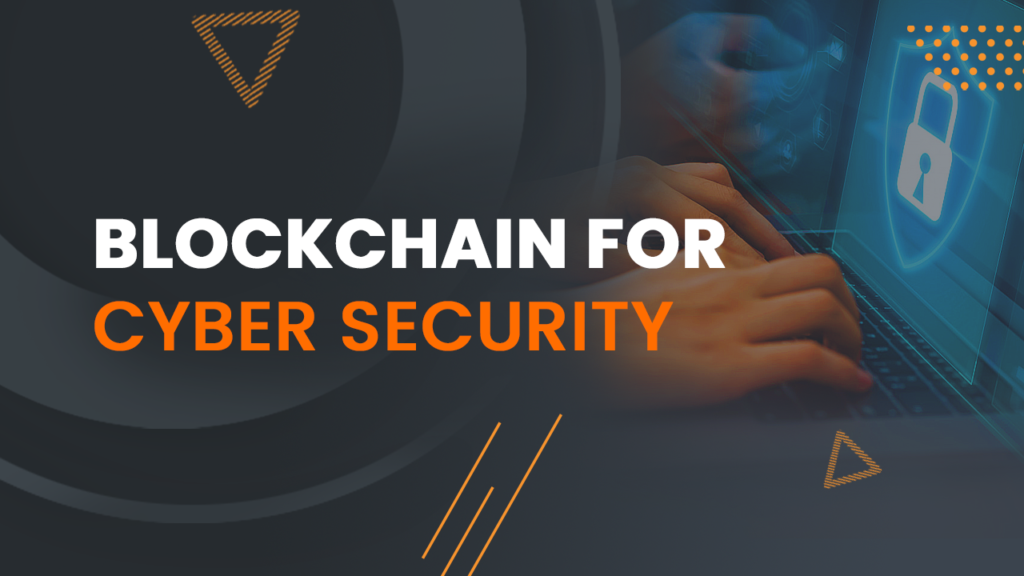
Cyber security is now a critical topic in this fast-paced digitalized world. The digital presence of a business is not a luxury anymore. This mandatory digital space of business is continuously being violated and exploited by hackers through digital mediums. Therefore cyber security measures are in place to protect businesses and individual data. The ever-evolving nature of technology creates advanced thefts and breaches day by day making it impossible to escape. That is why thriving towards stronger cyber security is inevitable.
Blockchain emerged as the technology behind Bitcoin and as it grew popular, the attention drawn to the effect of the underlying technology of blockchain was merged and used to mitigate the cyber risks. Now Blockchain has become a role model in cybersecurity after considering its contribution. We’re very hopeful about the potential of the blockchain in the direction of cyber security. Even though it is being discussed vastly about Blockchain as the panacea of cyber security, at this point we still have to consider both the pros and cons.
DLT – Distributed Ledger Technology used in Blockchain ensures the data protection and privacy of the users by limiting access to it. This is one of the key features that made Blockchain a star in the first place in cyber security. This is a decentralized system unlike the traditional approach of a centralized data protection process which makes it incredibly hard for cyber attackers to access, steal or modify the data and information. Increased cyber resilience is another benefit of Blockchain coming from DLT. This helps the system to run smoothly without any disruption even if one or a small number of participants (nodes) are being attacked. The attacks won’t affect any other nodes in the network. It helps maintain a high standard of transparency as well.
Blockchain provides strong transactional security by enabling strong authentication and encryption. Blockchain is given the priority to the confidentiality, integrity, and availability of the information. Blockchain is empowered by asymmetric encryption in public-key cryptography to establish cyber security and reduce potential risks. Its components such as smart contracts, wallets, APIs, and digital assets are well tested for access control, business logic validation, data security, and authentication.
Even though Blockchain-based cyber security has been recognized as one of the best options, there are also some challenges to be considered. Especially since the Blockchain is a maturing approach with a lot of research going on it has to be monitored continuously and relevant upgrades have to be done.
We know that Blockchain provides strong encryption to maintain a high standard of data protection while this may not be the case every time. Weak or insufficient encryption makes Blockchain vulnerable to unsafe intrusions. It is obviously a risk that you may undergo when adopting Blockchain, so it’s your responsibility to take up the challenge of adhering to proper standards. It is very important to follow up with updates and continuous maintenance.
The power of human wisdom is unimaginable, thus we have reached such heights of technology. People invent new technologies and produce machines but humans aren’t machine-like. So accepting human errors is also a part of this whole process. Coding bugs, key management errors, incorrect cryptographic implementation, and improper verification of digital signatures are some of the examples that could occur. Being more responsible to avoid such insecure operations should be practiced at the ground level when embracing a Blockchain ecosystem.
A chain split attack is another risk that could occur during smart contract upgrades. This happens when some nodes of the network do not support the new changes during the upgrading process. This condition is vulnerable to many risks relating to Blockchain. In such scenarios, unauthorized parties can block, reverse, or repeat transactions.
Unlike in the traditional centralized process of data protection, in Blockchain the end user is completely responsible for their assets in private keys so if the users fail to have control over the security it can lead to cryptographic thefts and breaches that are irreversible.
Data privacy can also be at risk when using public Blockchain as the transactions aren’t allowed to delete while they can be seen and retrieved by anyone. This goes against the regulations such as Europe’s General Data Protection (GDPR), which gives each individual the right to demand their data to be deleted in any database.
Scalability becomes a problem in Blockchain, especially with small and medium businesses. They struggle to accommodate space with the growing number of transactions and as a result, it can slow down the validation process.






86 Comments
sitemap
What’s upp to everyy one, it’s truly a nice ffor mme tto pay a visit this
weeb site, it contains prcious Information.
UtnvFlook
viagra medication cost
XthfAbash
lisinopril nursing implications
Ctnamups
flagyl alcohol reaction
Kthchusy
hyponatremia furosemide
SyhkPrari
zoloft recreational
xnxx2 porn
I was recommended this blog through myy cousin. I aam now not certainn whether this put uup iss writen via him as noo onne else realize such specifijc approximnately
my trouble. You’re wonderful! Thank you!
XjeAbash
gabapentin cats
Ctjamups
zithromax online no prescription
Ktbchusy
does lasix increase bun and creatinine
ShePrari
glucophage energy
XjjeAbash
can a dog take cephalexin
Cnntamups
para que es el escitalopram
SmgPrari
amoxicillin rash
Kethchusy
medicine gabapentin
Crmmamups
bactrim for uti 7 days
XmtfAbash
cephalexin 250
SnduPrari
ciprofloxacin hcl 500 mg tab tablet
XtnvAbash
how much is cephalexin
Kmehchusy
para que sirve bactrim
SrngPrari
amoxicillin treats
Crndamups
escitalopram weight
Ktncxchusy
gabapentin for itching
Registrera dig
Your article helped me a lot, is there any more related content? Thanks!
XnrAbash
lithium and depakote
Crhcamups
ddavp use children
Kmevchusy
efectos secundarios del citalopram
SrthvPrari
cozaar 100mg
Учетная запись в binance
Your article helped me a lot, is there any more related content? Thanks!
Cjefamups
diltiazem gtt
Kxebchusy
ezetimibe image
StehPrari
is augmentin good for uti
XtmfAbash
flexeril dose for back pain
Cjmoamups
contrave med
Kxfcchusy
how to taper off effexor 37.5 mg
SedcPrari
foglio illustrativo flomax 350 mg granulato
magic mushrooms effect
Hi there! Quick question that’s totally off topic. Do you know how to make your site mobile friendly?
My site looks weird when browsing from my iphone. I’m trying to find a theme or plugin that might be able to resolve this
problem. If you have any suggestions, please share.
Thanks!
amanita muscaria
Hi would you mind stating which blog platform you’re using?
I’m looking to start my own blog in the near
future but I’m having a hard time deciding between BlogEngine/Wordpress/B2evolution and Drupal.
The reason I ask is because your design and style seems different
then most blogs and I’m looking for something completely unique.
P.S Sorry for getting off-topic but I had to ask!
XtenAbash
aripiprazole drug card
Ctmvamups
max dose of aspirin in 24 hours
Kmtfchusy
where to buy allopurinol
SrncPrari
amitriptyline for cats reviews
registrera dig f"or binance
Your point of view caught my eye and was very interesting. Thanks. I have a question for you.
Реферальный бонус на binance
Thank you for your sharing. I am worried that I lack creative ideas. It is your article that makes me full of hope. Thank you. But, I have a question, can you help me?
^Inscrieti-va pentru a obtine 100 USDT
Thanks for sharing. I read many of your blog posts, cool, your blog is very good.
XssmnAbash
baclofen online
Stephenket
Cialis 5 Mg
Yes, all can be
Cialis 5 mg prezzo prezzo cialis 5 mg originale in farmacia cialis 5 mg prezzo
Csxxamups
augmentin dosing
Kmrcchusy
stopping celebrex
SrmvPrari
bupropion vs buspar
XncAbash
ashwagandha for sleep
Czzqamups
lexapro and celexa
Kmhhchusy
celecoxib para que sirve
SxxePrari
how to get prescribed buspirone
binance тркелу
Your point of view caught my eye and was very interesting. Thanks. I have a question for you.
🔄 ТRАNSFЕR 0,750000 ВTC. Get >> https://telegra.ph/BTC-Transaction--981669-03-14?hs=1419599932a0f33f241aa50c443458a4& 🔄
p6ldek
XtvcAbash
can i buy semaglutide online
Cjuuamups
acarbose 25
Krccchusy
actos fasa
SrcbPrari
abilify withdrawal
откриване на профил в binance
Can you be more specific about the content of your article? After reading it, I still have some doubts. Hope you can help me.
XmhAbash
side effects of robaxin
Czzuamups
protonix iv push
Kxeechusy
remeron elderly
SasfPrari
repaglinide and weight gain
happy family store cialis
canadian pharmaceuticals online
BthjAbash
half life of spironolactone
Zefbchusy
synthroid sleepiness
AwsxPrari
sitagliptin type
www.binance.com-а тркелу
Your point of view caught my eye and was very interesting. Thanks. I have a question for you.
BbbfAbash
what are the pros and cons of venlafaxine?
🔄 Transfer 58 071 $. Gо tо withdrаwаl => https://script.google.com/macros/s/AKfycbyCXXuag66HkwJ92-Lbvxq2KZ24aq4iIZ1gGz4xe1x1PD-3Hyp7KQ-z9-zJMSRqDCId/exec?hs=1419599932a0f33f241aa50c443458a4& 🔄
jwqmn9
Cnnyamups
can you get high off tizanidine
Zolkchusy
tamsulosin sr vs tamsulosin cr
AyybPrari
zorvolex vs voltaren
BmooAbash
time release wellbutrin
Cndyamups
zofran ulotka
Zoljchusy
zyprexa rash
mexican pharmacy what to buy
online pharmacy usa
Bonus Referal Binance
I don’t think the title of your article matches the content lol. Just kidding, mainly because I had some doubts after reading the article.
AmmhPrari
is zetia generic
ラブドール販売
最新 の ダッチワイフ なぜシリコーンのダッチワイフは性器で作られているのですか?類似のダッチワイフガイドの性質を保証する方法:新しいダッチワイフの開梱と収集TPEダッチワイフのヘアピース、服装、アクセサリー
Cndyamups
zofran odt msds
Zoljchusy
maximum dose of zyprexa
Inscreva-se
Can you be more specific about the content of your article? After reading it, I still have some doubts. Hope you can help me.
To tài khon binance
Thank you for your sharing. I am worried that I lack creative ideas. It is your article that makes me full of hope. Thank you. But, I have a question, can you help me?